This comprehensive article explores Solana's fundamentals, how to exchange USD to Solana, its technology, creator, value proposition, unique features, and the various possibilities it presents.
What is Solana?
Solana (SOL), often dubbed the "Ethereum killer," is a blockchain comparable to Ethereum, with its native SOL token available on major exchanges. What sets Solana apart is its innovative proof-of-history consensus mechanism, utilizing timestamps to determine the next block in its chain. In contrast to traditional proof-of-work systems like Bitcoin and Litecoin, Solana's approach is faster and more energy-efficient. While proof of work relies on miners, Solana's proof of history, and more recently, proof of stake used by Ethereum, introduces staking to define the next block, reducing energy consumption significantly. The SOL token gains value from facilitating efficient and forward-looking Solana network transactions.
Exchange USD To Solana
Begin by registering on our crypto platform and completing the KYC verification process to ensure account security and access platform features before proceeding to exchange your cryptocurrencies. Follow these straightforward steps for a secure experience.
1. Choose the "Get Started" button in the upper right corner of the PlasBit website to register, providing an email and a unique password.
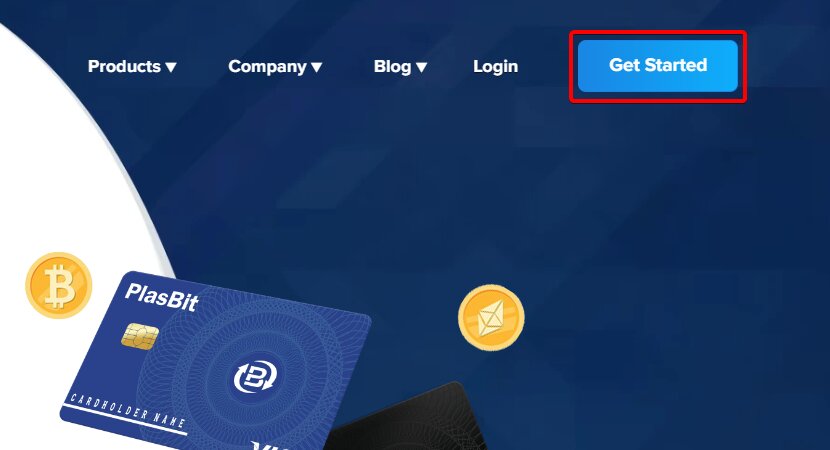
2. Afterward, go to the verification section on your dashboard and fulfill the Know Your Customer (KYC) procedure. To begin, select "Activate Verification."

3. Proceed to the "Exchange" tab.
oose Solana to buy.
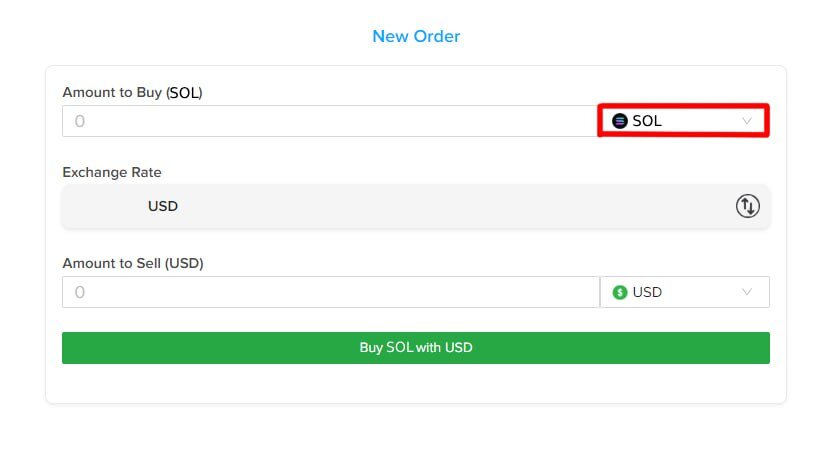
5. Input the amount of USD you want to sell in exchange for Solana.
6. Validate the total transaction amount details and select "Buy Solana with USD."
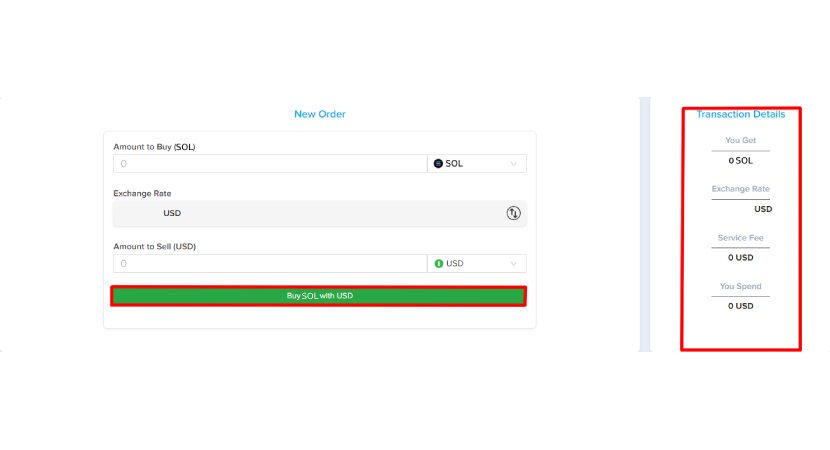
7. Upon confirmation, your wallet will reflect the amount of Solana you received.
Buy SOL with USD via Wire Transfer
To purchase Solana (SOL) with USD and deposit using our wire transfer, follow these steps to ensure a secure and successful transaction:
1. Navigate to the deposit section in your dashboard.

2. Choose USD as the currency for your deposit.
3. Enter the amount of currency you wish to credit and choose the 'SEPA' option for EURO deposits or the 'Swift' wire transfer option for USD deposits. Click 'Deposit' to proceed.
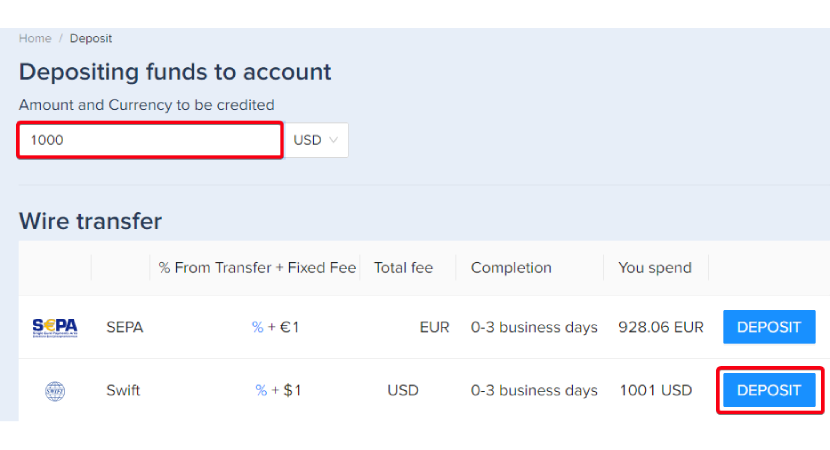
4. On the deposit details page, you will find PlasBit's bank information, including our exact beneficiary name, company address, IBAN, bank name, BIC/SWIFT, bank/branch address, and reference code. Important Note: You must include the reference code in the "Notes" section when you fill in the bank transfer request in your bank account
The code helps us identify your specific transfer.
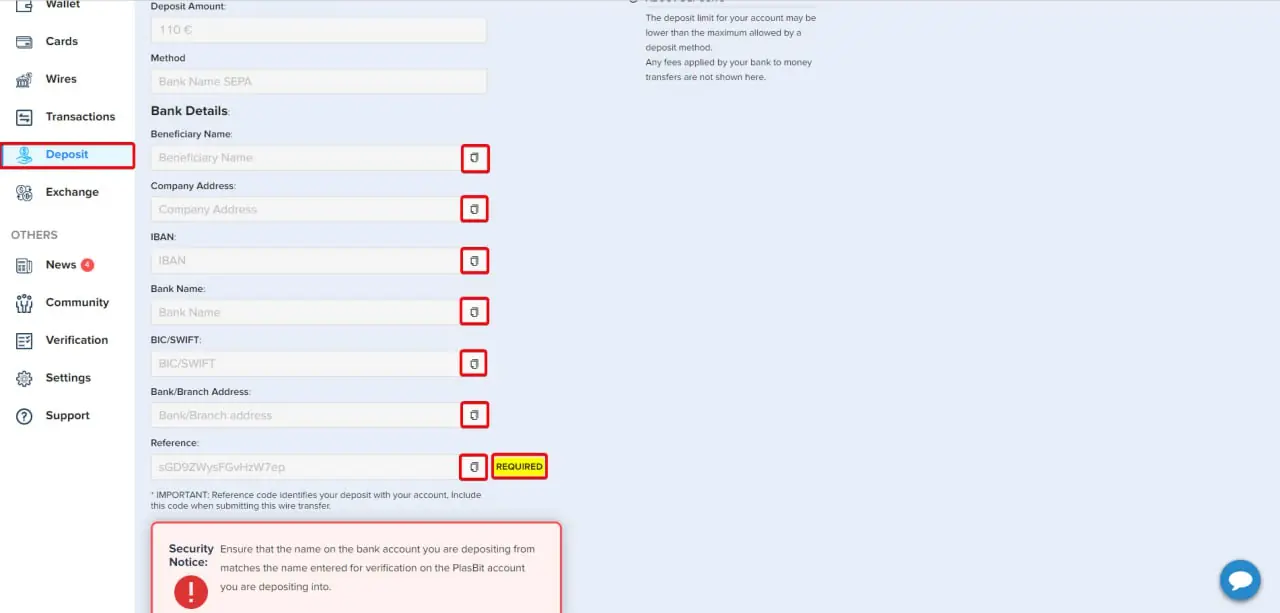
This guide will help you navigate the process of purchasing Solana with USD through our wire transfer.
Buy SOL with USD via Bank Card
Follow this guide to navigate the process effectively.
1. Begin by logging into PlasBit to access your account dashboard.
2. After logging in, proceed to the deposit section in your account.
3. Enter the USD amount you plan to use for acquiring Solana. Make sure your daily funding stays within the set limit.
4. Choose the bank card option in the deposit section and specify whether you have a Visa or Mastercard. Find details on transaction fees and the expected completion time.
5. Upon confirming the deposit amount and card selection, click the "Deposit" button.
6. You will be directed to a verification section containing essential deposit guidelines. Review and agree to these terms before advancing.
Deposit Guidelines:
1. Ensure your daily funding remains within the specified USD limit.
2. We exclusively accept plastic cards; virtual cards are not permissible.
3. Verify that the card is registered in your name.
4. Corporate or business cards are not accepted.
5. The card used for the deposit must be issued in the same country as your profile address.
6. You can utilize different cards, but up to two cards every 60 days.
7. Physically damaged cards are not accepted.
Verification Requirements:
1. The card used for the deposit.
2. Valid photo ID.
3. A digital camera or smartphone.
Upon receiving our email with instructions, follow the steps to take photos and upload them using the provided link. We will review the photos, and upon approval, your deposit will be processed automatically.
How Does Solana Work?
Solana's operational prowess is driven by a unique synthesis of proof-of-history and delegated proof-of-stake protocols, forming the bedrock of its transaction processing efficiency. Solana strategically employs innovative mechanisms to achieve high transaction throughput without compromising the fundamental tenets of blockchain. Let's explore the key components that make Solana a standout player in the blockchain arena, from its pioneering proof-of-history algorithm to the pivotal role played by SOL tokens in its multifaceted ecosystem.
Proof-of-History and Proof-of-Stake Fusion:
Solana's operational foundation lies in the strategic combination of proof-of-history and delegated proof-of-stake protocols. This innovative fusion is designed to expedite transaction processing without compromising the core tenet of decentralization.
High Transaction Throughput Objective:
According to insights from Bryan Routledge, an associate professor of finance at Carnegie Mellon University's Tepper School of Business, Solana sets out to achieve high transaction throughput. This objective distinguishes it from traditional centralized systems like Visa, which prioritizes speed through a vast network of computers, and Bitcoin, which emphasizes decentralization at the expense of transaction speed.
Protocol Balancing Speed and Decentralization:
Solana strikes a delicate balance by leveraging its efficient protocol to process transactions swiftly, comparable to centralized entities, while preserving the decentralized essence of blockchain technology. This approach enhances scalability, addressing one of the key challenges many blockchain networks face.
Minimization of Environmental and Monetary Costs:
The Solana protocol prioritizes speed and decentralization and emphasizes minimizing the environmental and monetary costs associated with blockchain operations. This reflects a commitment to sustainability and cost-effectiveness in the execution of transactions.
Proof-of-History Algorithm for Block Timestamping:
A critical component of Solana's architecture is the proof-of-history algorithm. This algorithm meticulously timestamps each block, ensuring a precise record of the chronological order of transactions. This timestamping mechanism plays a vital role in maintaining the security of the entire blockchain system.
Role of SOL Tokens in the Ecosystem:
SOL tokens are integral to the Solana ecosystem, serving multiple functions. These tokens are staked by participants, acting as validators or collateral for various transactions on the network. This dual role enhances the security and functionality of the Solana blockchain.
Participation in Staking and Validation:
Validators actively engage in staking SOL tokens, contributing to the decentralization of the blockchain network. This participation in staking allows validators to earn rewards, creating a system where token holders are incentivized to support the blockchain actively.
Collateral for Transaction Verification:
SOL tokens are utilized as collateral for a diverse range of transactions on the Solana network. From validating smart contracts to participating in the burgeoning Solana-powered non-fungible token (NFT) marketplace, SOL tokens play a pivotal role in the network's robust and multifaceted ecosystem.
Breakthrough in NFT Space:
Solana made a significant breakthrough in the non-fungible token (NFT) space in August 2021 with the launch of the Degenerate Ape Academy, the inaugural major NFT project on the Solana marketplace. This event triggered a substantial surge in Solana's value, underscoring its growing prominence in the NFT ecosystem.
Price Performance and All-Time High:
Notably, Solana's price experienced a remarkable journey, reaching an ATH (all-time high) of almost $260 in November 2021 during the peak of the broader crypto bull run. This performance reflects the market's recognition of Solana's technological advancements and ecosystem growth.
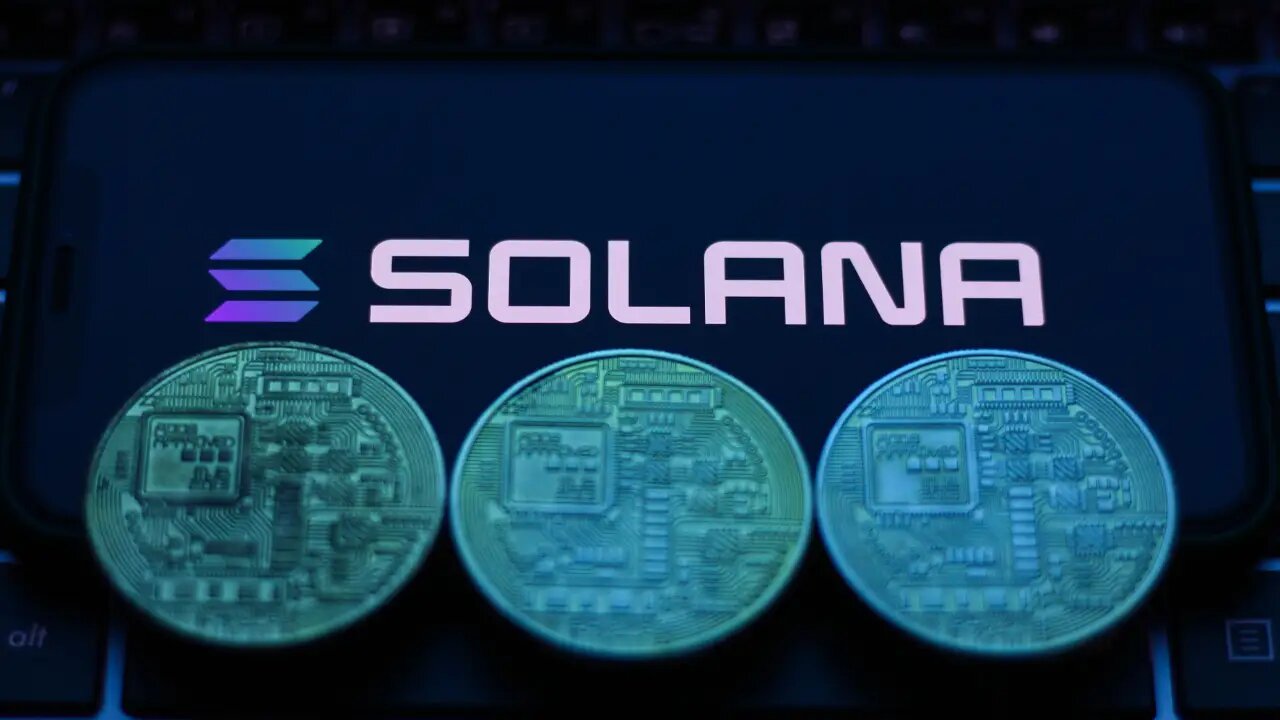
Who Created Solana (SOL)?
The visionary mind behind Solana, Anatoly Yakovenko, conceived the project in 2017 with the ambitious goal of creating a decentralized network of nodes capable of matching the performance of a single node. Overseeing the development of the Solana blockchain, Solana Labs serves as a key contributor, guided by Yakovenko's vision. Additionally, the Solana Foundation, a non-profit organization based in Switzerland, is key in supporting and expanding the community and funding ongoing development efforts. In 2018, Yakovenko and his team secured funding for Solana Labs, successfully raising over $20 million in a Series A funding round that extended into 2019. Following the mainnet launch in March 2020, Solana further bolstered its financial foundation by conducting a public token sale through the cryptocurrency auction platform CoinList, raising an additional $1.76 million. This strategic funding has played a crucial role in Solana's continued growth and development as it establishes itself as a prominent player in the blockchain space.
What Gives Solana Value?
Solana derives its distinctive value from eight core innovations that position it as a standout player in the blockchain arena, showcasing a high-performance infrastructure that surpasses many counterparts. These innovations collectively form the bedrock of Solana's scalability, providing a robust framework for global businesses seamlessly deploying cryptocurrency applications. The network's exceptional ability to outperform others becomes a magnet for users and developers seeking advanced capabilities in the dynamic landscape of decentralized technologies. Central to Solana's value proposition is its native cryptocurrency, SOL, which serves a dual role within the network. SOL holders actively contribute to the network's security by engaging in staking assuming roles as validator nodes or delegators. This staking mechanism proves financially rewarding for SOL holders, entitling them to a share of transaction fees and a substantial portion of newly minted tokens.
Beyond securing the network, SOL is a crucial component for developers and users navigating the Solana ecosystem, serving as the currency for paying transaction fees. As the Solana ecosystem expands, accommodating a growing number of transactions, the demand for SOL is expected to surge, enhancing its value and establishing it as a sought-after asset for stakers, developers, and users. In addition to the utility-driven value of SOL, Solana's commitment to continuous innovation and adaptability contributes to its overall appeal. Solana positions itself as a vibrant and forward-thinking solution in the competition of decentralized technologies by addressing the challenges faced by blockchain networks and prioritizing both performance and decentralization.
What Makes Solana Unique?
Solana sets itself apart in the competitive blockchain landscape through a strategic fusion of proof of history and delegated proof of stake. This distinctive combination translates into transaction speeds that outperform its major competitors, including Ethereum and Cardano (ADA) while maintaining high-cost efficiency. Departing from traditional proof-of-work and proof-of-stake models, Solana's proof of history introduces an innovative approach by integrating timestamps into the definition of blocks within its chain. Within this groundbreaking system, validators in the Solana blockchain actively vote to determine timestamps for different blocks. This unique consensus mechanism achieves an exceptional balance, preserving decentralization while facilitating rapid and secure computations. Solana's dedication to improving speed, security, and efficiency positions it as a prominent player in the blockchain space, providing a compelling alternative to the conventional consensus algorithms employed by other leading platforms. Solana's innovation extends beyond its consensus mechanisms to encompass a holistic commitment to addressing the challenges blockchain networks face. By prioritizing speed and decentralization, Solana offers a progressive solution that caters to the evolving needs of users and developers in the dynamic world of decentralized technologies.
Solana Price
SOL, the native cryptocurrency of Solana, serves a dual purpose within the ecosystem. Firstly, it is used to pay transaction fees on the Solana network. While Solana's fees are generally more cost-effective than those of other cryptocurrencies, users are still required to pay fees for sending transactions or executing smart contracts—these contracts being the foundational elements for advanced applications on Solana, spanning finance apps to music streaming platforms. Using smart contracts underscores Solana's commitment to streamlining digital transactions by eliminating intermediaries. Secondly, SOL facilitates the staking process, a common security measure many blockchains employ. Individuals desiring to contribute to the security of the Solana network can become validators by staking a portion of their SOL, effectively locking it up. This enhances the network's security and allows validators to earn rewards through additional SOL. It's important to note that Solana operates as an inflationary cryptocurrency, lacking a hard cap on the total token supply. The initial annual inflation rate stands at 8%, gradually decreasing by 15% each year until stabilizing at 1.5% as the fixed long-term rate. The distribution of SOL tokens saw a significant allocation to investors, Solana's team, and the Solana Foundation, emphasizing a balanced approach to fostering community growth and development. Since its launch in March 2020, SOL experienced fluctuations between $0.50 and $1.50 throughout the year, marking a notable surge during the crypto bull run in 2021, where it reached an all-time high of $258.93 in November 2021.
Buying Solana
Like many major cryptocurrencies, buying Solana involves navigating a diverse range of trading platforms where SOL tokens are actively traded. These tokens are not only accessible through traditional online exchanges but have also found their way into crypto and NFT ATMs in various cities worldwide. Once acquired, the prudent next step is securing your SOL tokens in a cryptocurrency wallet. Contrary to the name's suggestion, these wallets don't store the cryptocurrencies themselves but safeguard the keys necessary for ownership. You can opt for online or offline storage, with the latter, using a cold wallet, being considered the safest option. Beyond the intricacies of storage, SOL tokens boast many use cases, extending their utility far beyond mere trading.
You can leverage SOL tokens for peer-to-peer payments, engage in trading activities, and even act as incentives to contribute to the security of the Solana network by becoming validators—the diverse range of applications positions SOL as a versatile asset within the broader cryptocurrency ecosystem. However, potential traders must exercise caution and due diligence. Cryptocurrencies, including Solana, are renowned for their high volatility and inherent risks. Considering the unpredictable nature of the market, seeking advice from a financial advisor becomes a prudent step before delving into Solana. This advisory approach ensures you are well-informed about SOL's potential risks and rewards, aligning your decisions with your financial goals and risk tolerance. Traders need to approach cryptocurrency assets with a clear understanding that the market can be unpredictable, and they should only allocate amounts they can afford to lose, even in the presence of optimism about Solana's future potential.
What Can You Buy With Solana?
As a rapidly growing blockchain platform, Solana has witnessed an increasing adoption of its native cryptocurrency, SOL, across various sectors. The versatility of SOL extends beyond traditional venture and trading activities, offering you a range of use cases and opportunities to engage with the broader decentralized ecosystem.
DeFi Protocols and Yield Farming:
Solana has become a place for decentralized finance (DeFi) applications. You can participate in various decentralized protocols such as lending, borrowing, and liquidity provision to earn yields on their SOL holdings.
NFTs and Digital Art:
The Solana blockchain has emerged as a prominent space for non-fungible tokens (NFTs) and digital art. Artists and creators leverage SOL to mint and trade NFTs, enabling a vibrant digital collectibles and art marketplace on platforms like Solible and Magic Eden.
Gaming and Virtual Assets:
Solana is gaining traction in the gaming industry, with projects integrating SOL for in-game transactions and virtual assets. You can trade in-game items and assets using SOL, fostering a new era of decentralized gaming.
Peer-to-Peer Transactions:
SOL facilitates peer-to-peer transactions, enabling you to send and receive funds directly without intermediaries. This feature is precious for cross-border transactions, where SOL's speed and efficiency shine.
Decentralized Exchanges (DEX):
You can utilize SOL to trade various cryptocurrencies on decentralized exchanges built on the Solana blockchain. DEX platforms like Serum and Raydium allow you to swap assets, contribute liquidity, and earn rewards using SOL.
Governance Participation:
Some projects on the Solana blockchain incorporate governance mechanisms where SOL holders can actively participate in decision-making processes. By staking their SOL tokens, you gain voting power and influence the direction of decentralized projects.
Smart Contracts and DApps:
Developers can use SOL to deploy and execute smart contracts on the Solana blockchain. This functionality opens the door to a wide range of decentralized applications (DApps) that can be built and run on the platform.
Charitable Donations:
SOL can be used for charitable purposes, with some organizations accepting cryptocurrency donations. This use case emphasizes the broader societal impact of blockchain technology, allowing you to contribute to causes they support using SOL.
NFT Marketplaces and Platforms:
Besides digital art, SOL is used on NFT marketplaces for various digital assets, including virtual real estate, domain names, and virtual goods. These marketplaces leverage the blockchain's security and transparency for authenticating ownership and provenance.
Educational Services:
Some educational platforms and content creators accept SOL as payment for access to courses, tutorials, and educational materials. This highlights the diverse applications of SOL beyond the financial and digital world.
USD to SOL Crypto Calculator
Our crypto calculator is an indispensable tool designed for you and crypto/finance site owners seeking a seamless and efficient way to convert USD to Solana. This powerful calculator is valuable, offering real-time insights into the exchange rate between USD and SOL. It is pivotal in empowering users with accurate and up-to-date information, which is crucial for making informed decisions in the dynamic and volatile cryptocurrency market. PlasBit's crypto calculator ensures convenience and transparency in currency conversion, allowing you to effortlessly determine the equivalent value in SOL by inputting the desired amount in USD. This tool proves particularly beneficial for individuals engaging in SOL transactions, enabling them to stay abreast of the current exchange rate and make timely decisions based on precise calculations.
Beyond individual users, crypto and finance site owners can enhance their platforms by integrating our crypto calculator. The calculator's inclusion enriches the overall user experience by providing an invaluable tool for instant currency conversions. The user-friendly interface and real-time data create a positive experience, fostering your satisfaction and engagement. The calculator becomes a valuable asset for site owners in attracting a broader audience interested in Solana conversions, thereby increasing site traffic and expanding their user base. Moreover, the accuracy and reliability of our crypto calculator add a layer of credibility and professionalism to finance websites. Site owners can leverage this tool to position their platforms as trustworthy destinations for cryptocurrency-related information. The integration of our calculator not only contributes to user retention but establishes the site as a go-to resource for those seeking reliable Solana-related calculations.
Conclusion
Exploring the world of Solana (SOL) opens up possibilities within the decentralized ecosystem. Solana stands as a dynamic blockchain platform from its innovative proof-of-history consensus mechanism to its versatile applications in decentralized finance (DeFi), NFTs, gaming, and more. For those considering exchanging USD to Solana, the step-by-step guide provides a secure and transparent process on our platform. Solana's commitment to speed, efficiency, and continuous innovation makes it a good choice for users, developers, and traders. Whether you're diving into DeFi protocols and yield farming, engaging in governance participation, or exploring educational services, the diverse applications of SOL underscore its importance in shaping the future of decentralized technologies.






